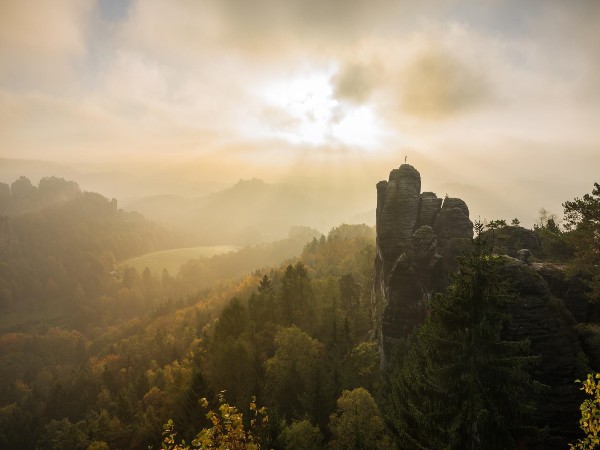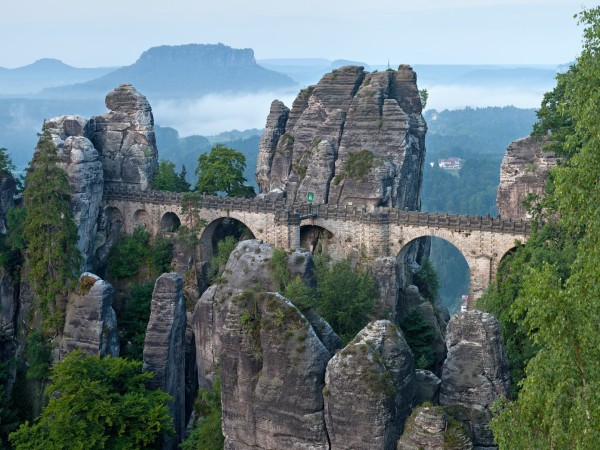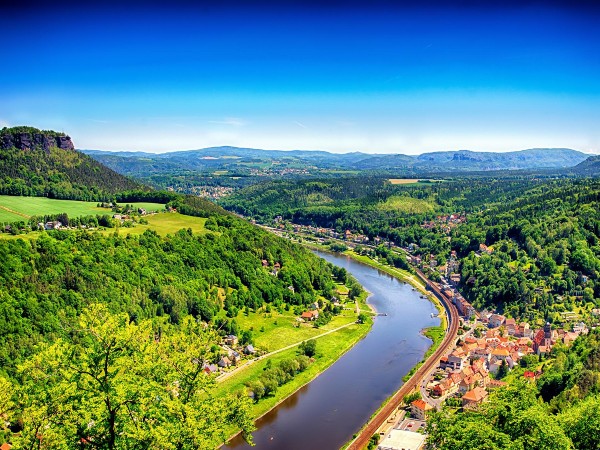Rising in the Czech Republic, the River Elbe enters Germany via a deep and shadowy gorge sliced through the Erzgebirge (Ore Mountains), then flows to the North sea. For most of its 720 miles (1160 km) the river is intensely serious. Along with associated waterways such as the Kiel canal, it is one of Europe's great commercial highways, bearing huge barge loads of coal, steel, grain, chemicals and manufactured goods on its ample bosom.
Only occasionally does this majestic stream reveal a romantic streak, such as the phalanxes of rocky bastions that suddenly loom out of either bank about an hour's journey south of Dresden. Carved by aeons of rain and frost out of sandstone laid down some 80 million years ago, they combine on a Gothic fantasy of towers and turrets, spires and domes divided by gorges wild with the roar of rushing streams and waterfalls.

Some formations stand alone, others are crowded in a manner that suggests a block in Manhattan. One such is the Bastei, a rocky labyrinth with a viewing point where you see, towering over the sparkling blue waters of the Amsel lake, the weird silhouette of the Lokomotive - a mountain-shaped like a steam engine. Other strange formations include the Lilienstein (the lily Stone), crowned by a ruined castle and the higgledy-piggledy bulk of the Pfaffenstien (the priest's stone). Near the town of Rathen is the Felsenbuhne, a natural theatre among the rocks where plays are performed in summer.

Historically, the area was known simply as the Meissen Highlands, a name too prosaic for its 19th century admires who renamed it Saxonian Switzerland. Shortly after the reunification of the country in 1990, the district was a national park. Before that, opportunities for military engineering had excited more attention than the scenery. Surviving witness of this is the Konigstein, a breathtaking citadel high on a crag above the Elbe. Built as a stronghold of the Bohemian kings in the early Middle Ages, it was later added to by the rulers (for Electors) of Saxony - Augustus the strong (1670-1733) gave it a fine Baroque exterior.

The building's inaccessibility underlined both its immunity from attack and its advantages as a prison. The most melancholy of its inmates must surely have been Johann Bottger, a brilliant young apothecary from Berlin who specialised in alchemy - attempting to turn base metals into gold. Having somehow upset the Prussian authorities, he fled to Saxony in 1700 and was promptly clapped into jail and put to work by Augustus, who was as anxious as any other prince of his day for an economical supply of gold.

Although Botteger's breakthrough failed to materialise, his abilities made a marked impression. As it happened, the Elector has a passion that over rose even that for gold. An inveterate collector of Chinese porcelain, he had amassed one of the Western World's finest collections. But his dream was to produce the first European porcelain, and it was to this end that Botteger was redirected. During years of incarceration, the recipe for porcelain seemed as elusive to him as that for gold.



 Click it and Unblock the Notifications
Click it and Unblock the Notifications






















